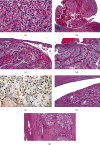Metastasis to the Bladder: A Rare Site of Recurrence of Renal Cell Carcinoma
- PMID: 35754920
- PMCID: PMC9232330
- DOI: 10.1155/2022/4339270
Metastasis to the Bladder: A Rare Site of Recurrence of Renal Cell Carcinoma
Abstract
Renal cell carcinoma (RCC) is considered to be the deadliest urologic cancer with high rates of metastasis and recurrence after nephrectomy. RCC can metastasize to nearly any organ but most commonly metastasizes to the liver, lung, brain, and bone. To date, there are only about 40 reported cases of RCC with solitary bladder metastasis. The following report contributes to this limited data set of patients with RCC who develop solitary metastasis to the bladder. A 69-year-old male presented with occasional gross hematuria and was found to have a left renal mass infiltrating the collecting system. Ureteroscopic biopsy revealed clear cell RCC, and the patient subsequently underwent radical left nephrectomy. Eight months after nephrectomy, the patient presented to the clinic with gross hematuria. In-office cystoscopy demonstrated a nodular lesion in the bladder arising from the left ureteral orifice. The patient underwent transurethral resection of the bladder mass and pathology demonstrated clear cell RCC. Subsequent imaging showed no evidence of metastatic disease. Five months after transurethral resection, the patient was found to have a left distal ureteral mass and underwent left ureterectomy with partial cystectomy. Pathology again demonstrated clear cell RCC. RCC with solitary metastasis to the bladder is rare, and there are no targeted guideline recommendations for management. Per standard of care, patients with painless hematuria and risk factors for malignancy should undergo cystoscopy. In patients with a history of RCC, metastasis to the bladder should be considered in the differential diagnosis. Patients with metastatic RCC to the bladder should undergo a thorough work-up for additional sites of metastasis. In patients with RCC who develop solitary bladder metastasis amenable to resection following nephrectomy, there is a lack of evidence to guide therapy and a multidisciplinary discussion is warranted. However, if the tumor is amenable to resection, metastasectomy is a reasonable therapeutic approach and offers the patient an improved quality of life and an opportunity for remission.
Copyright © 2022 Amanda Smart et al.
Conflict of interest statement
None of the authors have any relevant conflicts of interest.
Figures



Similar articles
-
[RENAL CELL CARCINOMA METASTASIS TO BLADDER DURING MOLECULAR TARGETED THERAPY WITH PAZOPANIB: REPORT OF TWO CASES].Nihon Hinyokika Gakkai Zasshi. 2020;111(2):58-61. doi: 10.5980/jpnjurol.111.58. Nihon Hinyokika Gakkai Zasshi. 2020. PMID: 33883361 Japanese.
-
[Bladder Metastasis of Renal Cell Carcinoma 7 Years after Ex Vivo Partial Nephrectomy and Auto-Transplantation : A Case Report].Hinyokika Kiyo. 2016 Nov;62(11):575-579. doi: 10.14989/ActaUrolJap_62_11_575. Hinyokika Kiyo. 2016. PMID: 27919135 Japanese.
-
[Solitary Bladder Metastasis of Chromophobe Renal Cell Carcinoma: Report of a Case].Hinyokika Kiyo. 2016 Feb;62(2):63-7. Hinyokika Kiyo. 2016. PMID: 27018407 Japanese.
-
Bladder metastasis from renal cell carcinoma: retrospective analysis of 65 reported cases.Clin Exp Metastasis. 2015 Feb;32(2):135-41. doi: 10.1007/s10585-015-9698-1. Epub 2015 Jan 29. Clin Exp Metastasis. 2015. PMID: 25630270 Review.
-
Extremely delayed solitary cerebral metastasis in patient with T1N0M0 renal cell carcinoma after radical nephrectomy: Case report and literature review.Medicine (Baltimore). 2021 Apr 16;100(15):e25586. doi: 10.1097/MD.0000000000025586. Medicine (Baltimore). 2021. PMID: 33847690 Free PMC article. Review.
Cited by
-
Metastatic Clear Renal Cell Carcinoma in Urinary Bladder at Presentation-A Rare Incidental Case Report and Literature Review.Clin Case Rep. 2025 Feb 10;13(2):e70199. doi: 10.1002/ccr3.70199. eCollection 2025 Feb. Clin Case Rep. 2025. PMID: 39935663 Free PMC article.
References
Publication types
LinkOut - more resources
Full Text Sources

